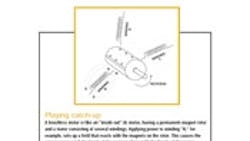Brushless motors are no different than ac or dc motors in that they rely on the interaction of magnetic fields to generate torque, and hence, motion. They are unique, however, both in construction and in the way they manipulate their torque-producing fields.
Brushless motors rely on semiconductor switches to turn stator windings on and off at the appropriate time. The process is called electronic commutation, borrowing on terminology used for the mechanism in dc motors, called a commutator, that switches current from winding to winding, forcing the rotor to turn.
The rotor in a typical brushless motor incorporates a four-pole permanent magnet and a smaller “sensor” magnet. The stator, on the other hand, consists of a three-phase, Y-connected winding and three Hall-effect sensors. The sensor magnet turns the Halleffect sensors “on” and “off,” indicating the position of the shaft. With this information, the controller is able to switch current to each winding at the optimum timing point.
Q. Is only one winding energized at a time?
A. In a three phase Y-connected stator, two or three windings may be energized at once. This makes efficient use of windings and develops higher motor torque.
Q. What type of power is applied to the coils?
A. Most brushless motor controls employ pulse width modulation (PWM) techniques to keep electronic devices cooler, thus allowing for smaller components.
Q. Are Hall sensors used exclusively?
A. Although Hall sensing is quite common, many industrial applications use electronic commutation schemes with resolver or encoder feedback.
About the Author
John Mazurkiewicz 1
Technical Advisor & Engineering Consultant
John Mazurkiewicz was a product manager at Baldor Electric/ABB for 19 years. Today he serves on several technical advisory boards, including that for the Penton Design Engineering & Sourcing Group.


